The diseases we research impact people's lives
Our researchers are dedicated to improving lives through neuroscience. Thanks to the generosity of all our donors, that we can continue our legacy of ground-breaking research.
Brazil Family Foundation
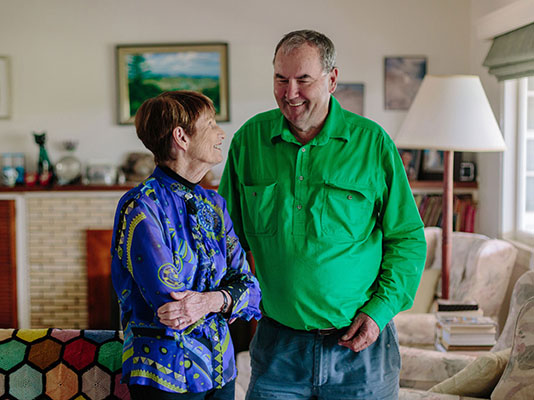
Recognising stroke and motor neurone disease (MND) had only limited treatment options and no cures prompted Lyn and Bobbie Brazil to establish the Brazil Family Program for Neurology in 2017. This enabled us to recruit world-leading researchers and support four laboratories.
Dr Adam Walker’s laboratory has defined some of the early triggers of MND to enable the best targeted approaches for therapies and identified ways to prevent the abnormal accumulation or improve the removal of a protein that causes motor neurons to die.
Dr Tara Walker is examining whether the dietary supplement selenium can prevent or decrease cognitive or motor deficits following stroke.
Dr Matilde Balbi aims to understand how stimulating the cortex in different ways reduces the loss of brain cells after a stroke and whether this mitigates behavioural deficits.
Professor Gail Robinson’s stroke research aims to improve cognitive assessment tests used to evaluate stroke survivors, in the acute phase, to predict long-term outcomes and to develop more targeted, personalised therapy strategies. Professor Robinson also aims to improve our understanding of the biological basis of MND.
The Brazil Family have also donated generously to our Alzheimer’s disease research. This gift contributed to Professor Jürgen Götz and his team’s ground-breaking therapeutic ultrasound approach to target dementia. This research has identified a range of potential applications for ultrasound, including delivering drugs into the brain. The intention is to modify disease progression and ultimately cure brain diseases.
Discovery research leads to the health outcomes of the future, but it takes time and support. Researchers need preliminary data to support their applications for grants. With government grant funding becoming harder to secure , scientists with promising research potential are being lost.
Funding of researchers who narrowly miss out on government grant funding could hold the key to major breakthroughs and, with support, could continue to explore new avenues and build the data needed to be successful in subsequent grant rounds.
The Brazil Family Foundation understands the power of “near-miss” applications and are supporting our scientists with a gift which enables them to continue collecting valuable data to improve their grant success in future funding rounds.
The whole of the QBI community pays tribute to the Brazil Family Foundation whose generosity and support enables us to continue our pathway to expanding our understanding of the brain, the underlying causes of brain disease and help develop new treatments which will benefit the community at large.
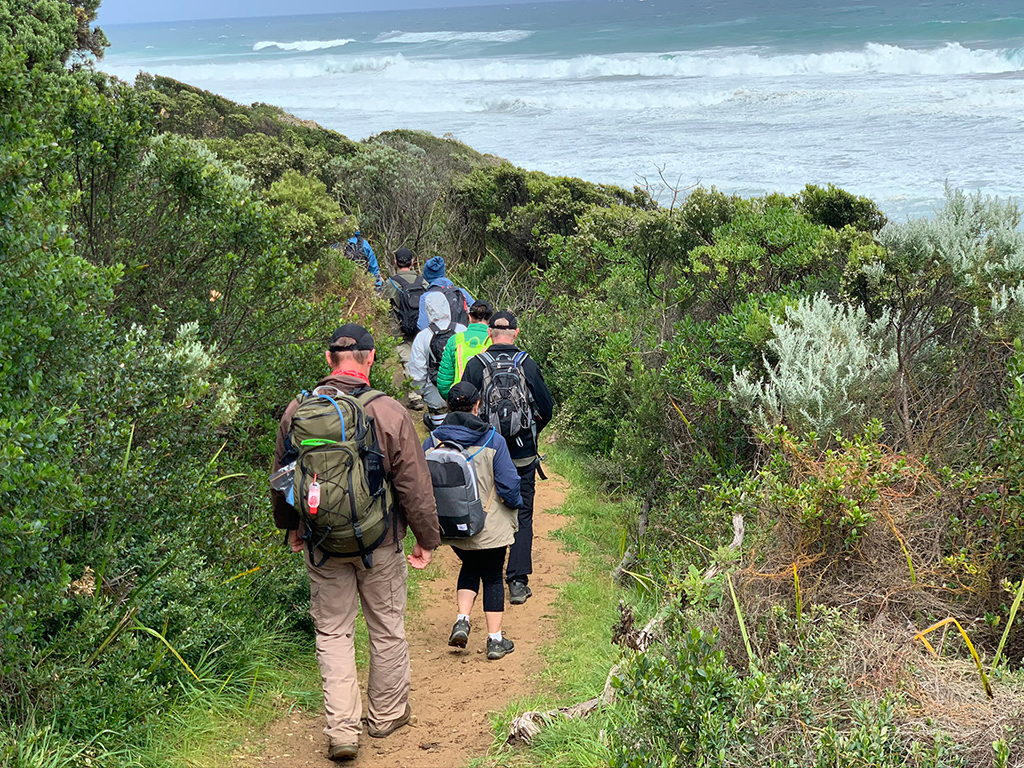
Great Ocean Walk, raised over $125 000 to support
brain research.
NFIA Trekkers do the hard yards for QBI
Through the hard work of Brian Davies, a successful businessman and immediate past-president and patron of the National Fire Industry Association (NFIA), and his wife, Liz, QBI was the joint-recipient of a donation of over $250 000 in 2019.
This incredible effort was the result of the NFIA Patron’s Walk held in October, which may sound like a scenic walk in the park but Brian, Liz and seven other NFIA members spent three days enduring driving rain and winds of close to 50 knots coming straight from Antarctica.
The idea for the walk came while the couple were completing the Three Capes Walk to raise money for the Queensland Brain Institute in 2018.
On that walk, Liz suggested to Brian that as the patron of the NFIA, he could create his own walk for charity. Mr Davies believes that corporate Australia has a big responsibility to give back, which is testament to the success of the inaugural walk. The money raised was shared between the Queensland Brain Institute and the Gallipoli Medical Research Foundation (GMRF).
The NFIA walk is the first of three walks to raise money for research at QBI and GMRF, with the aim of raising $500 000 in three years. The donation from the NFIA walk will help QBI’s research into motor neurone disease, dementia, Parkinson’s disease, stroke and QBI’s Discovery Research Endowment fund, which enables fundamental research into major health issues, including depression, anxiety, PTSD and epilepsy. QBI is extremely grateful to Brian and Liz and the NFIA team for their support.
The NFIA walk is the first of three walks to raise money for research at QBI and GMRF, with the aim of raising $500 000 in three years.
The Stafford Fox Medical Research Foundation
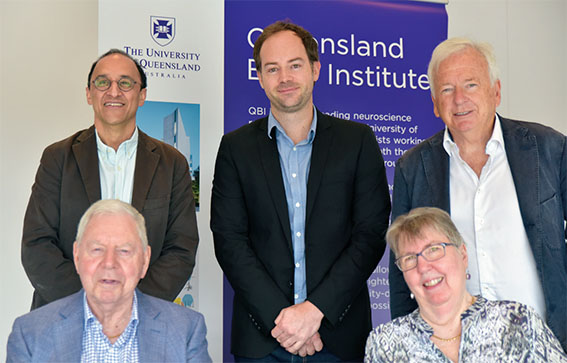
(QBI Director) and Dr Steven Zuryn and Emeritus Professor Perry Bartlett AO (back row).
In 2019, The Stafford Fox Medical Research Foundation confirmed its continued generous support of the prestigious $2.5 million philanthropically funded international fellowship to Dr Steven Zuryn at the Queensland Brain Institute to fight stroke-induced dementia, also known as vascular dementia. The Foundation also continues to support the work of Emeritus Professor Perry Bartlett’s research into prevention of dementia in ageing by improving cognition through exercise.
The Stafford Fox Medical Research Foundation was established in 2013 following the death of Moyna Fox, and named in honour of her late husband, James Stafford Fox, a former BP Australia chief executive.
Stafford and Moyna Fox started one of Australia’s wealthiest medical research foundations after many years of careful planning, resulting in a fund worth over $100 million. It was only publicly revealed in Moyna’s will when she died in 2013, many years after her husband.
James Stafford Fox was a private person, tall, physically imposing, but without a, particularly dominant personality. He rose from a position as a junior clerk at the Port Melbourne depot of the Commonwealth Oil Refineries (COR) in 1932, to become the first Australian chief executive of BP Australia Ltd in 1971.
James Stafford Fox spent three years at the helm of BP Australia, and retired in 1974 at age 60, remaining on several boards until 1985. By 1990, he was in poor health, suffering, among other things, from dementia. He entered a nursing home and died in 1994. By that time, he had already charted the course that would lead to the establishment of the foundation. Moyna lived on for more than 18 years, knowing what would happen after her death, but never revealing it publicly. Eventually, she too succumbed to dementia and died in 2013. The couple, who were so careful with their money and who clearly had no desire for fame and prominence during their lifetime, will now forever be remembered for their generosity in setting up the Stafford Fox Medical Foundation.
The Foundation’s support of QBI is crucial in enabling Emeritus Professor Bartlett and Dr Steven Zuryn to continue their work in finding solutions for the growing challenge of dementia today. This cutting- edge research is helping put Queensland and Australia at the forefront of world medical research.
What your donations fund
Your support can help us achieve a range of achievements

World leading research

Brightest scientific minds

Solutions to global health challenges
"I think it is important for people with dementia, their families and carers, to know that they are not forgotten, and that there’s a lot of work going on behind the scenes at QBI to try to unravel the tangled web that is dementia."
– Robyn Hilton (established the Peter Hilton Senior Research Fellowship in Ageing Dementia)
Hear from one of our supporters
Jeff Maclean, Chair of QBI Advisory Board
Got a story you would like to share?
Are you a donor or supporter of QBI and would like to share your story? We would love to hear from you!
Research in action
CNNE
The SUSTech-UQ Joint Centre for Neuroscience and Neural Engineering (CNNE) was officially opened in Shenzhen, China, in January 2020. The mission of the CNNE is to combine multi-disciplinary research teams to foster advances in Neuroscience and Neural Engineering that will dramatically increase the understanding of neuronal circuit computations, drive the development of next-generation in silico computational devices, and enhance the quality of life of Chinese and Australians impacted by disease and damage of the nervous system.
Co-Directors
Professor Pankaj Sah
Director & Professorial Research FellowQueensland Brain InstituteResearcher profile is public:1Supervisor:Researcher biography:Professor Pankaj Sah is Director of the Queensland Brain Institute (QBI) at The University of Queensland (UQ). He is renowned for his work in understanding the neural circuitry of the amygdala, an area of the brain that plays a central role in learning and memory formation. Dysfunction of the amygdala leads to a host of anxiety-related disorders. His laboratory uses a combination of molecular tools, electrophysiology, anatomical reconstruction, calcium imaging and behavioural studies to examine the electrophysiological signatures of different brain regions and their impact on disease. Recently, his laboratory has been working with patients undergoing electrode implantation for deep brain stimulation, which is used to treat a variety of disorders such as Parkinson's disease, Tourette's syndrome and essential tremor. Professor Sah trained in medicine at The University of New South Wales and, after completing his internship, gained a PhD from the Australian National University. Following postdoctoral work at the University of California, San Francisco, and UQ, he established his own laboratory at the University of Newcastle in 1994. He then joined the John Curtin School of Medical Research at the Australian National University as a group leader in 1997. He was recruited to QBI as a founding member in 2003, and has been Director since July 2015. Professor Sah has published over 110 papers in international peer-reviewed journals. He is also the Editor-in-Chief of the Nature Partner Journal npj Science of Learning, the first journal to bring together the findings of neuroscientists, psychologists, and education researchers to understand how the brain learns.
Body: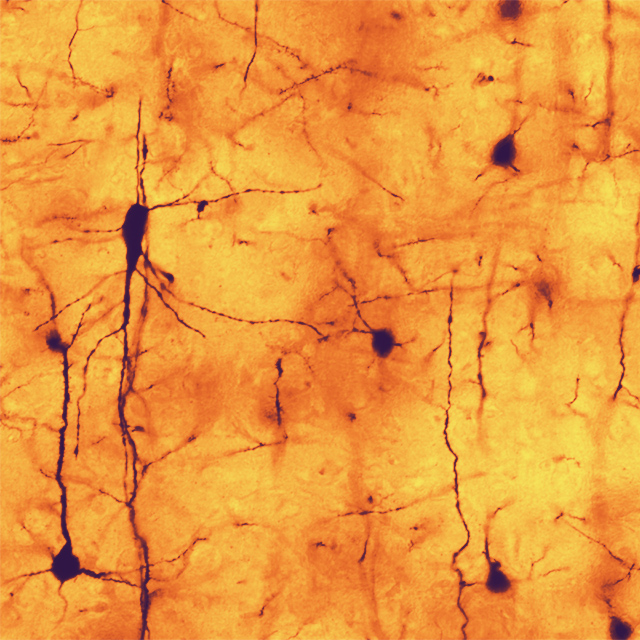 Professor Pankaj Sah: Synaptic Plasticity
Professor Pankaj Sah: Synaptic PlasticityThe Sah laboratory uses electrophysiology and molecular techniques, in conjunction with behavioural studies, to understand the neural circuitry that underpins learning and memory formation. Using animal models, the laboratory focusses on the part of the brain called the amygdala, and a Pavlovian learning paradigm called fear conditioning.
Professor Shengtao Hou
School of Life Sciences, Department of Biology, SUSTechResearcher profile is public:1Supervisor:Research Members
Emeritus Professor Perry Bartlett
Emeritus ProfessorQueensland Brain InstituteAffiliate of Clem Jones Centre for Ageing and Dementia ResearchClem Jones Centre for Ageing Dementia ResearchResearcher profile is public:0Supervisor:Body: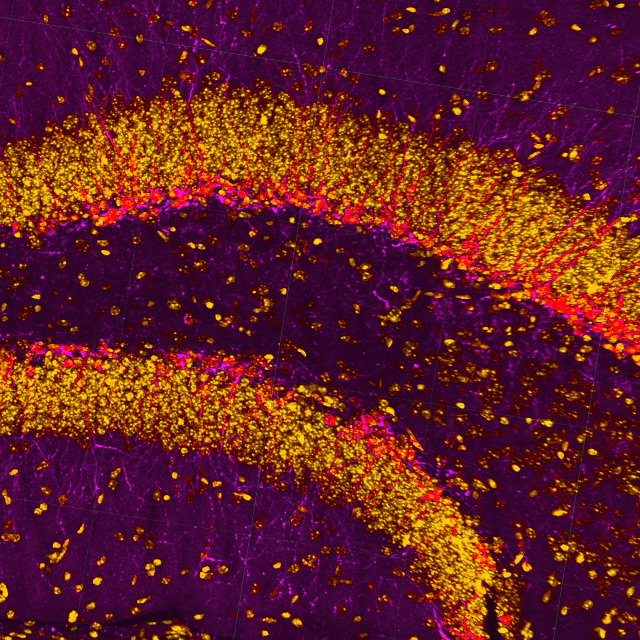 Emeritus Professor Perry Bartlett: Neurogenic regulation of cognition
Emeritus Professor Perry Bartlett: Neurogenic regulation of cognitionProfessor Perry Bartlett’s laboratory is focussed on understanding the mechanisms that regulate the production and function of new neurons, generated from the resident population of stem/precursor cells in a region of the adult brain known as the hippocampus.
Professor Helen Cooper
Professor and Associate Dean (Academic/Research/External Engagement/Other)Queensland Brain InstituteResearcher profile is public:1Supervisor:Body: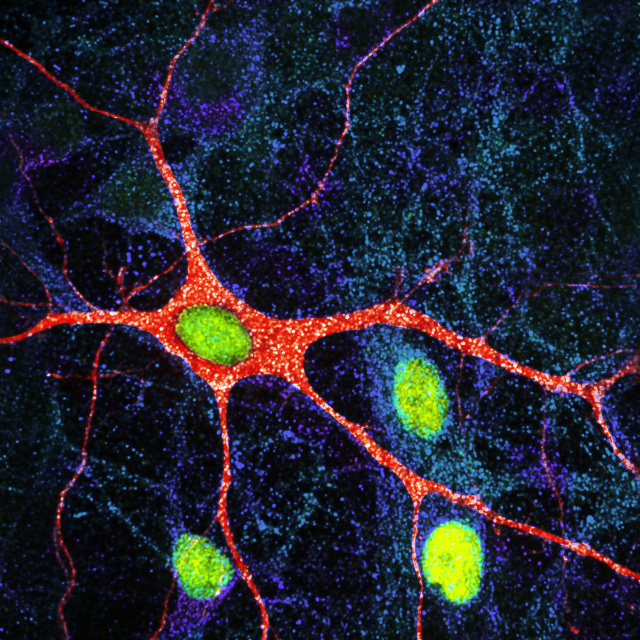 Professor Helen Cooper: Neural migration
Professor Helen Cooper: Neural migrationCurrent research in the Cooper laboratory explores the fundamental cellular and molecular mechanisms governing the development of the neocortex. The group has identified unexpected, novel roles for the axon guidance receptors Neogenin (a netrin receptor) and Ryk (a Wnt receptor) in neural stem cell biology, neurogenesis, dendrite outgrowth and synaptogenesis. The Cooper group has shown that loss of these receptors in the mouse leads to cortical malformations which are equivalent to those seen in humans.
Professor Frederic Meunier
Professor and Academic Senior Group/Unit Leader/SupervisorQueensland Brain InstituteAffiliate of Clem Jones Centre for Ageing and Dementia Research & Affiliate of Clem Jones Centre for Ageing and Dementia ResearchClem Jones Centre for Ageing Dementia ResearchResearcher profile is public:1Supervisor:Researcher biography:Professor Frederic Meunier obtained his Masters degree in Neurophysiology at the Paris XI University, France in 1992 and completed his Ph.D in Neurobiology at the CNRS in Gif-sur-Yvette, France in 1996. He was the recipient of a European Biotechnology Fellowship and went on to postgraduate work at the Department of Biochemistry at Imperial College (1997-1999) and at Cancer Research UK (2000-2002) in London, UK. After a short sabbatical at the LMB-MRC in Cambridge (UK), he became a group leader at the School of Biomedical Sciences at the University of Queensland (Australia) in 2003. He joined the Queensland Brain Institute of the University of Queensland in 2007 and obtained an NHMRC senior research fellowship in 2009 renewed in 2014 with promotion. He became Professor in 2014 at the Queensland Brain Institute and is currently part of the Centre for Ageing Dementia Research.
Body: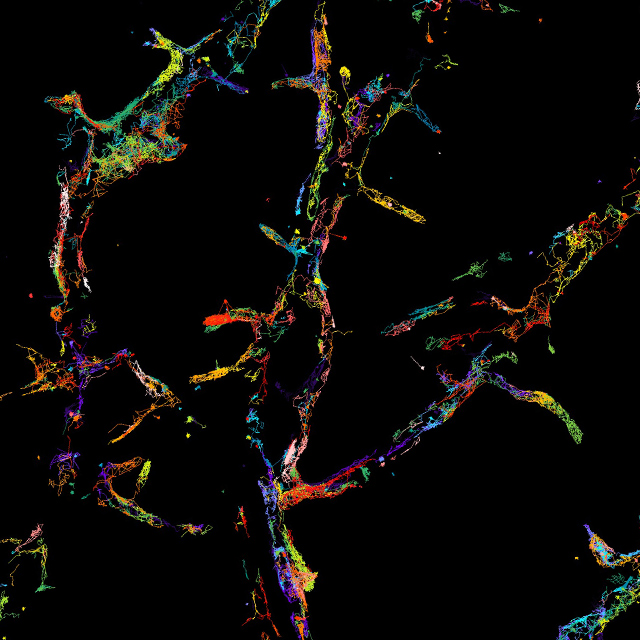 Professor Frederic Meunier: Single Molecule Neuroscience Laboratory
Professor Frederic Meunier: Single Molecule Neuroscience LaboratoryThe overall goal of our research is to determine how brain cells communicate and survive in health and disease. Our lab focuses on the molecular events that govern vesicular trafficking within presynaptic nerve terminals and neurosecretory cells. Our discoveries have led to a deep understanding of how secretory vesicles interact with the cortical actin network prior to fusing with the plasma membrane to release the neurotransmitter.
Selected recent publications
Visualizing endocytic recycling and trafficking in live neurons by subdiffractional tracking of internalized molecules
Joensuu, Merja, Martinez-Marmol, Ramon, Padmanabhan, Pranesh, Glass, Nick R., Durisic, Nela, Pelekanos, Matthew, Mollazade, Mahdie, Balistreri, Giuseppe, Amor, Rumelo, Cooper-White, Justin J., Goodhill, Geoffrey J. and Meunier, Frederic A. (2017) Nature Protocols, 12 12:2590-2622. doi:10.1038/nprot.2017.116In vivo single-molecule imaging of syntaxin1A reveals polyphosphoinositide- and activity-dependent trapping in presynaptic nanoclusters
Bademosi, Adekunle T., Lauwers, Elsa, Padmanabhan, Pranesh, Odierna, Lorenzo, Chai, Ye Jin, Papadopulos, Andreas, Goodhill, Geoffrey J., Verstreken, Patrik, Van Swinderen, Bruno and Meunier, Frederic A. (2017) Nature Communications, 8 . doi:10.1038/ncomms13660Subdiffractional tracking of internalized molecules reveals heterogeneous motion states of synaptic vesicles
Joensuu, Merja, Padmanabhan, Pranesh, Durisic, Nela, Bademosi, Adekunle T. D., Cooper-Williams, Elizabeth, Morrow, Isabel C., Harper, Callista B., Jung, WooRam, Parton, Robert G., Goodhill, Geoffrey J., Papadopulos, Andreas and Meunier, Frederic A. (2016) Journal of Cell Biology, 215 2: 277-292. doi:10.1083/jcb.201604001Flux of signalling endosomes undergoing axonal retrograde transport is encoded by presynaptic activity and TrkB
Wang, Tong, Martin, Sally, Nguyen, Tam H., Harper, Callista B., Gormal, Rachel S., Martinez-Marmol, Ramon, Karunanithi, Shanker, Coulson, Elizabeth J., Glass, Nick R., Cooper-White, Justin J., Van Swinderen, Bruno and Meunier, Frederic A. (2016) Nature Communications, 7 . doi:10.1038/ncomms12976The Munc18-1 domain 3a hinge-loop controls syntaxin-1A nanodomain assembly and engagement with the SNARE complex during secretory vesicle priming
Kasula, Ravikiran, Chai, Ye Jin, Bademosi, Adekunle T., Harper, Callista B., Gormal, Rachel S., Morrow, Isabel C., Hosy, Eric, Collins, Brett M., Choquet, Daniel, Papadopulos, Andreas and Meunier, Frederic A. (2016) The Journal of Cell Biology, 214 7: 847-858. doi:10.1083/jcb.201508118Munc18-1 is a molecular chaperone for α-synuclein, controlling its self-replicating aggregation
Chai, Ye Jin, Sierecki, Emma, Tomatis, Vanesa M., Gormal, Rachel S., Giles, Nichole, Morrow, Isabel C., Xia, Di, Götz, Jürgen, Parton, Robert G., Collins, Brett M., Gambin, Yann and Meunier, Frédéric A. (2016) The Journal of Cell Biology, 214 6: 705-718. doi:10.1083/jcb.201512016Profiling of free fatty acids using stable isotope tagging uncovers a role for saturated fatty acids in neuroexocytosis
Narayana, Vinod K., Tomatis, Vanesa M., Wang, Tong, Kvaskoff, David and Meunier, Frederic A. (2015) Cell Chemistry and Biology, 22 11: 1552-1561. doi:10.1016/j.chembiol.2015.09.010Control of autophagosome axonal retrograde flux by presynaptic activity unveiled using botulinum neurotoxin type A
Wang, Tong, Martin, Sally, Papadopulos, Andreas, Harper, Callista B., Mavlyutov, Timur A., Niranjan, Dhevahi, Glass, Nick R., Cooper-White, Justin J., Sibarita, Jean-Baptiste, Choquet, Daniel, Davletov, Bazbek and Meunier, Frederic A. (2015) Journal of Neuroscience, 35 15: 6179-6194. doi:10.1523/JNEUROSCI.3757-14.2015Activity-driven relaxation of the cortical actomyosin II network synchronizes Munc18-1-dependent neurosecretory vesicle docking
Papadopulos, Andreas, Gomez, Guillermo A., Martin, Sally, Jackson, Jade, Gormal, Rachel S., Keating, Damien J., Yap, Alpha S. and Meunier, Frederic A. (2015) Nature Communications, 6 6297: 1-11. doi:10.1038/ncomms7297An acto-myosin II constricting ring initiates the fission of activity-dependent bulk endosomes in neurosecretory cells
Gormal, Rachel S, Nguyen, Tam H, Martin, Sally, Papadopulos, Andreas and Meunier, Frederic A (2015) Journal of Neuroscience, 35 4: 1380-1389. doi:10.1523/JNEUROSCI.3228-14.2015Dr Tara Walker
Research Fellow & Group Leader, Senior Research FellowQueensland Brain InstituteAffiliate of Clem Jones Centre for Ageing and Dementia ResearchClem Jones Centre for Ageing Dementia ResearchResearcher profile is public:1Supervisor:Researcher biography:Dr Tara Walker is a Senior Research Associate at the Queensland Brain Institute. Dr Walker's group is investigating the mechanisms governing the lifelong production of neurons in the adult brain (adult neurogenesis). Tara studied Biotechnology as an undergraduate at the Queensland University of Technology (Brisbane, Australia), before carrying out her PhD in the field of Plant Biotechnology. In 2003 she made the transition to neuroscience, joining the Queensland Brain Institute (QBI) and the group of Professor Perry Bartlett. Here she became interested in the field of adult hippocampal neurogenesis, particularly in its activity-dependent regulation. In 2010, she joined the group of Professor Gerd Kempermann at the Center for Regenerative Therapies in Dresden, Germany, where she was awarded a Marie Curie International Incoming Fellowship in 2011. In July 2018 she returned to QBI to take up a position in the newly developed Centre for Restorative Neurosciences as a Senior Research Associate, where she will apply her knowledge of neural stem cell biology to stroke research.
Body:Research interest
We are interested in understanding the fundamental mechanisms governing the lifelong production of neurons in the adult brain. Adult neurogenesis, as this process is termed, decreases with age and this age-related decline in neurogenesis results in an associated decline in learning processes that are controlled by the hippocampus.
In previous work, together with Professor Perry Bartlett, we provided the first evidence of a true, but normally latent, hippocampal stem cell population and identified a mechanism through which the production of new neurons could be stimulated to replace or repair damaged cells in neurodegenerative diseases. More recently our focus has been on the systemic regulation of adult neurogenesis. We use the physical exercise model of increased neurogenesis to investigate cross-talk between the brain and the peripheral immune system, and in this context have investigated the interaction between T cells, mast cells and platelets and the neural stem cell niche.
The control of cell death provides a key mechanism in the regulation of adult hippocampal neurogenesis. We have demonstrated that ferroptosis, a recently identified, caspase-3-independent mode of programmed cell death, is a fundamental mechanism underlying the regulation of adult hippocampal neurogenesis. This form of cell death is mediated by the dietary trace element selenium. We have shown that selenium supplementation results in increased neural progenitor cell survival and neuronal-lineage differentiation in the hippocampus of young adult and aged mice. Ferroptotic cell death has been linked to the cell death that occurs in a number of neurodegenerative diseases and stroke. A key aspect of our future research program will be to investigate whether blocking ferroptotic cell death via dietary or environmental interventions can rescue the behavioural and cognitive decline observed in an animal model of stroke.
Dr Zhaoyu Li
Group LeaderQueensland Brain InstituteResearcher profile is public:1Supervisor:Body: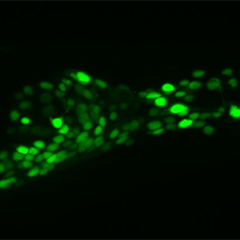 Dr Zhaoyu Li: Neural circuit and behaviour
Dr Zhaoyu Li: Neural circuit and behaviourThe Li group uses C. elegans, currently the only organism with a completely mapped connectome, to address these questions. We employ multifaceted approaches including calcium imaging, optogenetics, behavioural genetic screen and molecular genetics to study the function and dysfunction of neural network in healthy and diseased animals.
Dr Matilde Balbi
Senior Research FellowQueensland Brain InstituteResearcher profile is public:1Supervisor:Researcher biography:Dr. Matilde Balbi is a neuroscientist within the Queensland Brain Institute, The University of Queensland. After receiving her bachelor and master's degree in Medical Biotechnology from the University of Naples,Italy, she spent a year working on traumatic brain injury at the Royal College of Surgeons in Ireland as a research assistant. Dr. Balbi earned her Ph.D. in Neuroscience at the Ludwig Maximilians University in Munich, Germany, working on the regulation of cerebral blood flow in health (ageing) and disease (small vessel disease and subarachnoid haemorrhage). She completed her postdoctoral training at the University of British Columbia in Vancouver, Canada, where she received support and fellowships from the Leducq Foundation, CPSR, MSFHR. She now leads her laboratory which aims to make an impact on the field of stroke recovery and other pathological conditions by combining imaging techniques, brain stimulation and individually tailored recovery paradigms in behaving rodents.
Body: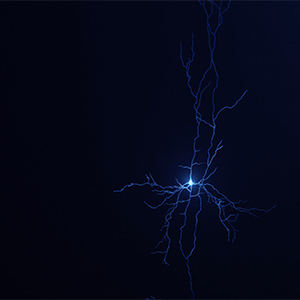 Dr Matilde Balbi: Neuromodulation and homeostatic processes
Dr Matilde Balbi: Neuromodulation and homeostatic processesThe Balbi lab employs a multi-level approach, combining in vivo imaging techniques, brain stimulation—including but not exclusively optogenetics—and AI driven, individually tailored recovery paradigms in behaving rodents, to investigate intrinsic neuroprotective mechanisms of the brain under pathological conditions such as stroke.
Dr Chen Fangyi
Research ScientistDepartment of Biomedical Engineering, SUSTechResearcher profile is public:1Supervisor:Professor Chen Wei
School of Life Sciences, Department of Biology, SUSTechResearcher profile is public:1Supervisor:Assistant Professor Xiaojing Chen
School of Life Sciences, Department of Biology, SUSTechResearcher profile is public:1Supervisor:Assistant Professor Longzhen Cheng
School of Life Sciences, Department of Biology, SUSTechResearcher profile is public:1Supervisor:Associate Professor Sheng-Jian Ji
School of Life Sciences, Department of Biology, SUSTechResearcher profile is public:1Supervisor:Dr Quanying Liu
Department of Biomedical Engineering, SUSTechResearcher profile is public:1Supervisor:Dr Kun Song
School of Life Sciences, Department of Biology, SUSTechResearcher profile is public:1Supervisor:Assistant Professor Xiaoying Tang
Department of Electrical and Electronic Engineering, SUStechResearcher profile is public:1Supervisor:Associate Professor Zhiyi Wei
School of Life Sciences, Department of Biology, SUSTechResearcher profile is public:1Supervisor:Professor Bo Xiao
School of Life Sciences, Department of Biology, SUSTechResearcher profile is public:1Supervisor:Dr Mingming Zhang
Department of Biomedical Engineering, SUSTechResearcher profile is public:1Supervisor:Associate Professor Dong Liu
School of Life Sciences, Department of Biology, SUSTechResearcher profile is public:1Supervisor:Students
Yiran Zhao, PhD Student, SUSTech. UQ Supervisor: Dr Zhaoyu Li
- Department of Biomedical Engineering, SUSTech

